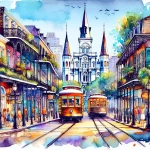Situated in a prime location within New Orleans, the Tulane/Gravier neighborhood embodies the essence of the city’s diverse cultural heritage. With a history spanning centuries, this area has undergone a remarkable transformation, evolving from its humble origins into a thriving community that captures the spirit of the Crescent City.
In This Article
TL;DR
- Tulane/Gravier’s historical evolution, from an industrial hub to a diverse residential enclave, has played a pivotal role in shaping New Orleans’ identity.
- The neighborhood boasts a unique demographic composition, reflecting the city’s melting pot of cultures and socioeconomic backgrounds.
- Iconic landmarks, such as historic breweries and influential institutions, define the area’s character and contribute to its allure.
Historical Context of Tulane/Gravier
Early Settlement and Development
The origins of Tulane/Gravier can be traced back to the late 17th century when European Jesuits established a settlement in the area. Over time, the land changed hands, eventually becoming part of the growing city of New Orleans. As the city expanded, so did the neighborhood, transforming from a rural outpost into an industrial zone.
Industrial and Residential Growth
The 19th century witnessed a surge of industrial activity in Tulane/Gravier, with the establishment of iconic breweries like Falstaff and Dixie. These landmarks not only provided employment opportunities but also became integral parts of the community’s identity. As the 20th century dawned, the area underwent a gradual shift, evolving into a mixed residential and commercial district. Shotgun houses and camelback cottages sprang up, reflecting the architectural styles that have become synonymous with New Orleans.
Demographic and Economic Overview
Population Changes
Tulane/Gravier’s population has undergone significant transformations over the decades. Early census data reveals a predominantly working-class community, with a diverse mix of ethnicities and backgrounds. More recent estimates indicate a gradual shift towards a more affluent demographic, driven by redevelopment initiatives and the influx of young professionals.
Economic Challenges and Growth
Like many urban neighborhoods, Tulane/Gravier has faced its share of economic challenges. However, concerted efforts by community organizations and local businesses have fostered growth and revitalization. Today, the area boasts a thriving commercial district along major thoroughfares like Tulane Avenue and Broad Street, while residential zones continue to attract new residents seeking an authentic New Orleans living experience.
Architectural and Cultural Landmarks
Historic Buildings and Breweries
The Falstaff and Dixie Breweries stand as iconic reminders of Tulane/Gravier’s industrial past. While no longer operational, these historic structures have been repurposed, serving as cultural hubs and event spaces that celebrate the neighborhood’s heritage.
Influential Institutions
St. Joseph’s Church and University Hospital are two institutions that have played pivotal roles in the community’s development. St. Joseph’s, with its striking architecture and rich history, serves as a spiritual anchor for many residents, while University Hospital continues to provide vital healthcare services to the area.
Community and Lifestyle
Residential Life
Tulane/Gravier’s residential areas are a tapestry of architectural styles, with shotgun homes and camelback cottages dotting the landscape. These unique dwellings, often adorned with vibrant colors and intricate ironwork, offer a glimpse into the neighborhood’s past while catering to modern living. Recent years have seen a surge in new housing developments, attracting a diverse mix of residents seeking an authentic New Orleans experience.
Cultural Diversity and Social Fabric
The neighborhood’s cultural diversity is celebrated through various festivals and community events throughout the year. From block parties to art walks, these gatherings showcase the rich tapestry of influences that have shaped Tulane/Gravier’s identity. The area’s social fabric is further strengthened by active neighborhood associations and community organizations that work tirelessly to preserve the area’s heritage while fostering a sense of belonging.
Economic Development and Infrastructure
Commercial Growth and Challenges
Major commercial corridors like Tulane Avenue and Broad Street have experienced significant growth in recent years, with an influx of new businesses catering to the changing demographics. However, this growth has also brought challenges, such as increased traffic and parking concerns, which the community continues to address through collaborative efforts.
Infrastructure Improvements
Recognizing the importance of a robust infrastructure, the city has undertaken various projects to improve the neighborhood’s streets, utilities, and public spaces. These ongoing efforts aim to enhance the quality of life for residents while attracting further investment and development.
Education and Public Services
Educational Facilities
Tulane/Gravier is home to a variety of educational institutions, ranging from highly regarded primary schools to prestigious universities. These institutions not only provide quality education but also contribute to the area’s intellectual and cultural vibrancy.
Public Services and Amenities
Residents of Tulane/Gravier enjoy access to a range of public services and amenities, including well-maintained parks, community centers, and libraries. Additionally, the neighborhood’s proximity to major healthcare facilities ensures that residents have access to quality medical care.
Future Outlook and Development Plans
Redevelopment Strategies
With a focus on sustainable growth and preserving the area’s unique character, various redevelopment strategies are underway in Tulane/Gravier. These initiatives aim to strike a balance between revitalizing the neighborhood’s commercial and residential sectors while maintaining its historic charm.
Community Goals and Initiatives
Community-led initiatives play a crucial role in shaping the future of Tulane/Gravier. Neighborhood associations and advocacy groups work tirelessly to ensure that development plans align with the community’s goals, prioritizing affordable housing, small business support, and the preservation of cultural landmarks.
Challenges and Opportunities
Urban Challenges
Like many urban areas, Tulane/Gravier faces challenges such as gentrification, economic disparity, and housing affordability. These issues require thoughtful solutions that balance progress with the preservation of the neighborhood’s character and diversity.
Opportunities for Growth
Despite the challenges, Tulane/Gravier presents numerous opportunities for growth and development. The area’s rich cultural heritage, coupled with its prime location and vibrant community spirit, make it an attractive destination for tourism and local business investment. By capitalizing on these strengths while addressing existing challenges, Tulane/Gravier can continue to thrive as a vibrant and authentic New Orleans neighborhood.






